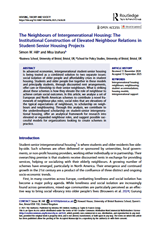The Neighbours of Intergenerational Housing: The Institutional Construction of Elevated Neighbour Relations in Student-Senior Housing Projects

A free online research article by Taylor & Francis online of the University of Bristol research project provides a useful analysis of 16 European and North American students-seniors intergenerational housing projects and offers a novel framework on the dynamics of neighbouring in these housing circumstances.
The articles review a variety of successful intergenerational projects where student-senior relationships actively provide everything from a ‘good neighbour’ or neighbourhood-plus roles and befriending to offering care and social support, as well as mutual mentoring. It also explored whether, as part of campus expansion, the opportunity for “a pilot project which could test how new models of intergenerational housing could support older people’s access to, and participation in, higher education, while helping respond to the challenges of increased demand on student accommodations within the city-region”. What emerged were three types of student-senior housing:
“mutually beneficial intergenerational housing” populated by students and seniors designed for social interaction;
“pre-existing care homes or supported accommodation” that brought students in to live with older residents and provide practical and emotional support; and
“upmarket owner-occupied retirement housing” developed on a university campus with student residents.
And, on the design front, the article highlights a number of spatial considerations of co-living; from the scheme layout and clustering of flats to utilisation of and privacy in common parts or shared services.
If you found this of interest, check out a range of other resources on intergenerational housing curated by the Housing LIN as well as the current Call for Evidence by the APPG on Housing and Care for Older People Inquiry into Creating Intergenerational Communities (deadline 17 October 2025).
